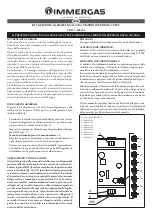
15
WHL-015 REV. 1.13.17
Cold weather handling
– If appliance has been stored in a very cold location (below 0
o
F) before installation, handle with care until the
plastic components come to room temperature.
Remove all sides of the shipping crate to allow the appliance to be lifted into its installation location. If surface flooring is rough, take
care when sliding appliance into position, as you could damage the appliance.
Carefully consider installation when determining appliance location. Please read the entire manual before attempting installation.
Failure to properly take factors such as appliance venting, piping, condensate removal, and wiring into account before installation could
result in wasted time, money, and possible property damage and personal injury.
B. BEFORE LOCATING THE APPLIANCE
Incorrect ambient conditions can lead to damage to the heating system and put safe operation at risk. Ensure that the appliance
installation location adheres to the information included in this manual. Failure to do so could result in property damage, serious
personal injury, or death.
Failure of appliance or components due to incorrect operating conditions IS NOT covered by product warranty.
1. Installation Area (Mechanical Room) Operating Conditions
Ensure ambient temperatures are higher than 32
o
F/0
o
C and lower than 104
o
F/40
o
C.
Prevent the air from becoming contaminated by the products, places, and conditions listed in this manual.
Avoid continuously high levels of humidity
Never close existing ventilation openings
The service life of the appliance
’s exposed metallic surfaces, such as the casing, as well as internal surfaces, such as the heat
exchanger, are directly influenced by proximity to damp and salty marine environments. In such areas, higher concentration levels of
chlorides from sea spray coupled with relative humidity can lead to degradation of the heat exchanger and other appliance components.
In these environments, appliances must not be installed using direct vent systems which draw outdoor air for combustion. Such
appliances must be installed using room air for combustion. Indoor air will have a much lower relative humidity and, hence, potential
corrosion will be minimized.
This appliance is certified for indoor installations only. Do not install the appliance outdoors. Failure to install this appliance indoors
could result in substantial property damage, severe personal injury, or death.
This appliance must be installed as described in this manual: upright, with the vent adapters in the vertical position. DO NOT attempt to
install this appliance in any other orientation. Doing so will result in improper appliance operation and property damage, and could result
in serious personal injury or death.
2. Check for nearby connections to:
System water piping
Venting connections
Gas supply piping
Electrical power
Condensate drain
Locate the appliance where any leakage from the relief valve, related piping, tank, or connections will not result in damage to
surrounding areas or lower floors of the building. The appliance should be located near a floor drain, or installed in an adequately
drained drain pan. Westinghouse WILL NOT be held liable for leakage damages.
To conserve water and energy, insulate all water piping, especially the hot and recirculation water lines.
3. Check area around appliance. Remove any combustible materials, gasoline, and other flammable liquids.
Summary of Contents for WBRC 140F Series
Page 2: ...2 WHL 015 REV 1 13 17 ...
Page 43: ...43 WHL 015 REV 1 13 17 Figure 29 140F Model Electrical Wiring Diagram ...
Page 44: ...44 WHL 015 REV 1 13 17 Figure 30 140F Model Ladder Diagram ...
Page 45: ...45 WHL 015 REV 1 13 17 Figure 31 199F Model Electrical Wiring Diagram ...
Page 46: ...46 WHL 015 REV 1 13 17 Figure 32 199F Model Ladder Diagram ...
















































